Analyses of All Small Molecule-Based Pentacene/C60 Organic Photodiodes Using Vacuum Evaporation Method
Abstract
:1. Introduction
2. Experimental Methods
3. Results and Discussion
3.1. J–V Characteristics Depending on the Interfacial Layers
3.2. Device Performance with Variable Active Layer Thickness
4. Conclusions
Supplementary Materials
Author Contributions
Funding
Data Availability Statement
Conflicts of Interest
References
- Ng, T.N.; Wong, W.S.; Chabinyc, M.L.; Sambandan, S.; Street, R.A. Flexible image sensor array with bulk heterojunction organic photodiode. Appl. Phys. Lett. 2008, 92, 213303. [Google Scholar] [CrossRef]
- Jansen-van Vuuren, R.D.; Armin, A.; Pandey, A.K.; Burn, P.L.; Meredith, P. Organic Photodiodes: The Future of Full Color Detection and Image Sensing. Adv. Mater. 2016, 28, 4766–4802. [Google Scholar] [CrossRef] [PubMed]
- Kamada, T.; Hatsumi, R.; Watanabe, K.; Kawashima, S.; Katayama, M.; Adachi, H.; Ishitani, T.; Kusunoki, K.; Kubota, D.; Yamazaki, S. OLED display incorporating organic photodiodes for fingerprint imaging. J. Soc. Inf. Display 2019, 27, 361–371. [Google Scholar] [CrossRef]
- Guo, H.T.; Saifi, S.; Fukuda, K.; Cheng, H.M.; Lou, Z.R.; Xu, X.M. Flexible organic photodetectors and their use in wearable systems. Digit. Signal Process 2022, 125, 103145. [Google Scholar] [CrossRef]
- Xu, H.H.; Yin, L.; Liu, C.; Sheng, X.; Zhao, N. Recent Advances in Biointegrated Optoelectronic Devices. Adv. Mater. 2018, 30, 1800156. [Google Scholar] [CrossRef]
- Li, N.; Eedugurala, N.; Leem, D.S.; Azoulay, J.D.; Ng, T.N. Organic Upconversion Imager with Dual Electronic and Optical Readouts for Shortwave Infrared Light Detection. Adv. Funct. Mater. 2021, 31, 2100565. [Google Scholar] [CrossRef]
- Shan, T.; Hou, X.; Yin, X.K.; Guo, X.J. Organic photodiodes: Device engineering and applications. Front. Optoelectron. 2022, 15, 49. [Google Scholar] [CrossRef]
- Shekhar, H.; Solomeshch, O.; Liraz, D.; Tessler, N. Low dark leakage current in organic planar heterojunction photodiodes. Appl. Phys. Lett. 2017, 111, 223301. [Google Scholar] [CrossRef]
- Fallahpour, A.H.; Kienitz, S.; Lugli, P. Origin of Dark Current and Detailed Description of Organic Photodiode Operation under Different Illumination Intensities. IEEE Tran. Electron. Dev. 2017, 64, 2649–2654. [Google Scholar] [CrossRef]
- Lv, L.; Yu, J.D.; Sui, X.Y.; Wu, J.F.; Dong, X.H.; Lu, G.H.; Liu, X.F.; Peng, A.D.; Huang, H. Significant enhancement of responsivity of organic photodetectors upon molecular engineering. J. Mater. Chem. C 2019, 7, 5739–5747. [Google Scholar] [CrossRef]
- Nath, D.; Dey, P.; Joseph, A.M.; Rakshit, J.K.; Roy, J.N. CuPc/C-60 heterojunction for high responsivity zero bias organic red light photodetector. Appl. Phys. A-Mater. 2020, 126, 627. [Google Scholar] [CrossRef]
- Huang, Y.C.; Huang, Z.H.; Wang, T.Y.; Chaudhary, P.; Hsu, J.F.; Lee, K.M. A promising non-fullerene acceptor for near-infrared organic photodetectors operating with low dark current and high response speed. Chem. Eng. J. 2023, 464, 142633. [Google Scholar] [CrossRef]
- Keivanidis, P.E.; Ho, P.K.H.; Friend, R.H.; Greenham, N.C. The Dependence of Device Dark Current on the Active-Layer Morphology of Solution-Processed Organic Photodetectors. Adv. Funct. Mater. 2010, 20, 3895–3903. [Google Scholar] [CrossRef]
- Valouch, S.; Hones, C.; Kettlitz, S.W.; Christ, N.; Do, H.; Klein, M.F.G.; Kalt, H.; Colsmann, A.; Lemmer, U. Solution processed small molecule organic interfacial layers for low dark current polymer photodiodes. Org. Electron. 2012, 13, 2727–2732. [Google Scholar] [CrossRef]
- Huang, X.D.; Zhao, Z.M.; Chung, S.; Cho, K.L.; Lv, J.; Lu, S.R.; Kan, Z.P. Balancing the performance and stability of organic photodiodes with all-polymer active layers. J. Mater. Chem. C 2022, 10, 17502–17511. [Google Scholar] [CrossRef]
- Park, J.B.; Ha, J.W.; Yoon, S.C.; Lee, C.; Jung, I.H.; Hwang, D.H. Visible-Light-Responsive High-Detectivity Organic Photodetectors with a 1 mu m Thick Active Layer. ACS Appl. Mater. Int. 2018, 10, 38294–38301. [Google Scholar] [CrossRef]
- Zhang, Z.Z.; Lin, Y.Z. Organic Semiconductors for Vacuum-Deposited Planar Heterojunction Solar Cells. ACS Omega 2020, 5, 24994–24999. [Google Scholar] [CrossRef] [PubMed]
- Yang, D.Z.; Zhou, X.K.; Ma, D.G. Fast response organic photodetectors with high detectivity based on rubrene and C60. Org. Electron. 2013, 14, 3019–3023. [Google Scholar] [CrossRef]
- Ren, H.; Chen, J.D.; Li, Y.Q.; Tang, J.X. Recent Progress in Organic Photodetectors and their Applications. Adv. Sci. 2021, 8, 2002418. [Google Scholar] [CrossRef]
- Bonifacio, V.D.B.; Pires, R.F. Photodiodes: Principles and recent advances. J. Mater. NanoScience 2019, 6, 38–46. [Google Scholar]
- Xie, B.M.; Chen, Z.X.; Ying, L.; Huang, F.; Cao, Y. Near-infrared organic photoelectric materials for light-harvesting systems: Organic photovoltaics and organic photodiodes. Infomat 2020, 2, 57–91. [Google Scholar] [CrossRef]
- Guo, D.C.; Yang, D.Z.; Zhao, J.C.; Vadim, A.; Ma, D.G. Role of interfaces in controlling charge accumulation and injection in the photodetection performance of photomultiplication-type organic photodetectors. J. Mater. Chem. C 2020, 8, 9024–9031. [Google Scholar] [CrossRef]
- Yoo, S.; Potscavage, W.J.; Domercq, B.; Han, S.H.; Li, T.D.; Jones, S.C.; Szoszkiewicz, R.; Levi, D.; Riedo, E.; Marder, S.R.; et al. Analysis of improved photovoltaic properties of pentacene/C60 organic solar cells:: Effects of exciton blocking layer thickness and thermal annealing. Solid State Electron. 2007, 51, 1367–1375. [Google Scholar] [CrossRef]
- Kielar, M.; Dhez, O.; Pecastaings, G.; Curutchet, A.; Hirsch, L. Long-Term Stable Organic Photodetectors with Ultra Low Dark Currents for High Detectivity Applications. Sci. Rep. 2016, 6, 39201. [Google Scholar] [CrossRef] [PubMed]
- Simone, G.; Dyson, M.J.; Weijtens, C.H.L.; Meskers, S.C.J.; Coehoorn, R.; Janssen, R.A.J.; Gelinck, G.H. On the Origin of Dark Current in Organic Photodiodes. Adv. Opt. Mater. 2020, 8, 1901568. [Google Scholar] [CrossRef]
- Gong, X.O.; Tong, M.H.; Park, S.H.; Liu, M.; Jen, A.; Heeger, A.J. Semiconducting Polymer Photodetectors with Electron and Hole-blocking Layers: High Detectivity in the Near-Infrared. Sensors 2010, 10, 6488–6496. [Google Scholar] [CrossRef]
- Friedel, B.; Keivanidis, P.E.; Brenner, T.J.K.; Abrusci, A.; McNeill, C.R.; Friend, R.H.; Greenham, N.C. Effects of Layer Thickness and Annealing of PEDOT:PSS Layers in Organic Photodetectors. Macromolecules 2009, 42, 6741–6747. [Google Scholar] [CrossRef]
- Zheng, Y.C.; Fischer, A.; Sergeeva, N.; Reineke, S.; Mannsfeld, S.C.B. Exploiting lateral current flow due to doped layers in semiconductor devices having crossbar electrodes. Org. Electron. 2019, 65, 82–90. [Google Scholar] [CrossRef]
- Tang, Z.; Ma, Z.F.; Sanchez-Diaz, A.; Ullbrich, S.; Liu, Y.; Siegmund, B.; Mischok, A.; Leo, K.; Campoy-Quiles, M.; Li, W.W.; et al. Polymer: Fullerene Bimolecular Crystals for Near-Infrared Spectroscopic Photodetectors. Adv. Mater. 2017, 29, 1702184. [Google Scholar] [CrossRef]
- Kublitski, J.; Hofacker, A.; Boroujeni, B.K.; Benduhn, J.; Nikolis, V.C.; Kaiser, C.; Spoltore, D.; Kleemann, H.; Fischer, A.; Ellinger, F.; et al. Reverse dark current in organic photodetectors and the major role of traps as source of noise. Nat. Commun. 2021, 12, 551. [Google Scholar] [CrossRef]
- Kaiser, C.; Schellhammer, K.S.; Benduhn, J.; Siegmund, B.; Tropiano, M.; Kublitski, J.; Spoltore, D.; Panhans, M.; Zeika, O.; Ortmann, F.; et al. Manipulating the Charge Transfer Absorption for Narrowband Light Detection in the Near-Infrared. Chem. Mater. 2019, 31, 9325–9330. [Google Scholar] [CrossRef]
- Kyndiah, A.; Cramer, T.; Albonetti, C.; Liscio, F.; Chiodini, S.; Murgia, M.; Biscarini, F. Charge Transfer and Percolation in C60/Pentacene Field-Effect Transistors. Adv. Electron. Mater. 2015, 1, 1400036. [Google Scholar] [CrossRef]
- Kang, J.H.; da Silva, D.; Bredas, J.L.; Zhu, X.Y. Shallow trap states in pentacene thin films from molecular sliding. Appl. Phys. Lett. 2005, 86, 152115. [Google Scholar] [CrossRef]
- Nicolai, H.T.; Kuik, M.; Wetzelaer, G.A.H.; de Boer, B.; Campbell, C.; Risko, C.; Bredas, J.L.; Blom, P.W.M. Unification of trap-limited electron transport in semiconducting polymers. Nat. Mater. 2012, 11, 882–887. [Google Scholar] [CrossRef] [PubMed]
- Sergeeva, N.; Ullbrich, S.; Hofacker, A.; Koerner, C.; Leo, K. Structural Defects in Donor-Acceptor Blends: Influence on the Performance of Organic Solar Cells. Phys. Rev. Appl. 2018, 9, 024039. [Google Scholar] [CrossRef]
- Cowan, S.R.; Leong, W.L.; Banerji, N.; Dennler, G.; Heeger, A.J. Identifying a Threshold Impurity Level for Organic Solar Cells: Enhanced First-Order Recombination via Well-Defined PC84BM Traps in Organic Bulk Heterojunction Solar Cells. Adv. Funct. Mater. 2011, 21, 3083–3092. [Google Scholar] [CrossRef]
- Hofacker, A.; Neher, D. Dispersive and steady-state recombination in organic disordered semiconductors. Phys. Rev. B 2017, 96. [Google Scholar] [CrossRef]
- Wu, Z.H.; Li, N.; Eedugurala, N.; Azoulay, J.D.; Leem, D.S.; Ng, T.N. Noise and detectivity limits in organic shortwave infrared photodiodes with low disorder. NPJ Flex. Electron. 2020, 4, 6. [Google Scholar] [CrossRef]
- Yoon, S.; Ha, J.; Sim, K.M.; Cho, W.; Chung, D.S. Systematic optimization of low bandgap polymer/[6,6]-phenyl C-70 butyric acid methyl ester blend photodiode via structural engineering. Org. Electron. 2016, 35, 17–23. [Google Scholar] [CrossRef]
- Lee, C.C.; Estrada, R.; Li, Y.Z.; Biring, S.; Al Amin, N.R.A.; Li, M.Z.; Liu, S.W.; Wong, K.T. Vacuum-Processed Small Molecule Organic Photodetectors with Low Dark Current Density and Strong Response to Near-Infrared Wavelength. Adv. Opt. Mater. 2020, 8, 2000519. [Google Scholar] [CrossRef]
- Simone, G.; Dyson, M.J.; Meskers, S.C.J.; Janssen, R.A.J.; Gelinck, G.H. Organic Photodetectors and their Application in Large Area and Flexible Image Sensors: The Role of Dark Current. Adv. Funct. Mater. 2020, 30, 1904205. [Google Scholar] [CrossRef]
- Credgington, D.; Kim, Y.; Labram, J.; Anthopoulos, T.D.; Durrant, J.R. Analysis of Recombination Losses in a Pentacene/C-60 Organic Bilayer Solar Cell. J. Phys. Chem. Lett. 2011, 2, 2759–2763. [Google Scholar] [CrossRef]
- Lenes, M.; Koster, L.J.A.; Mihailetchi, V.D.; Blom, P.W.M. Thickness dependence of the efficiency of polymer: Fullerene bulk heterojunction solar cells. Appl. Phys. Lett. 2006, 88, 243502. [Google Scholar] [CrossRef]
- Nam, Y.M.; Huh, J.; Jo, W.H. Optimization of thickness and morphology of active layer for high performance of bulk-heterojunction organic solar cells. Sol. Energ. Mat. Sol. Cells 2010, 94, 1118–1124. [Google Scholar] [CrossRef]
- Chaudhary, S.; Yadav, V.; Singh Negi, C.M.; Gupta, S.K. Active layer thickness dependence of optoelectronic performance in CH3NH3PbI3 perovskite-based planar heterojunction photodiodes. Opt. Mater. 2020, 106, 109960. [Google Scholar] [CrossRef]
- Nath, D.; Dey, P.; Joseph, A.M.; Rakshit, J.K.; Roy, J.N. Zero bias high responsive visible organic photodetector based on pentacene and C-60. Opt. Laser Technol. 2020, 131, 106393. [Google Scholar] [CrossRef]
- Yang, J.J.; Huang, J.; Li, R.M.; Li, H.; Sun, B.; Lin, Q.Q.; Wang, M.; Ma, Z.F.; Vandewal, K.; Tang, Z. Cavity-Enhanced Near-Infrared Organic Photodetectors Based on a Conjugated Polymer Containing [1,2,5]Selenadiazolo[3,4-c]Pyridine. Chem. Mater. 2021, 33, 5147–5155. [Google Scholar] [CrossRef]
- Wang, Y.Z.; Siegmund, B.; Tang, Z.; Ma, Z.F.; Kublitski, J.; Xing, S.; Nikolis, V.C.; Ullbrich, S.; Li, Y.G.; Benduhn, J.; et al. Stacked Dual-Wavelength Near-Infrared Organic Photodetectors. Adv. Opt. Mater. 2021, 9, 2001784. [Google Scholar] [CrossRef]
- Skumanich, A. Optical-Absorption Spectra of Carbon 60 Thin-Films from 0.4 to 6.2 Ev. Chem. Phys. Lett. 1991, 182, 486–490. [Google Scholar] [CrossRef]
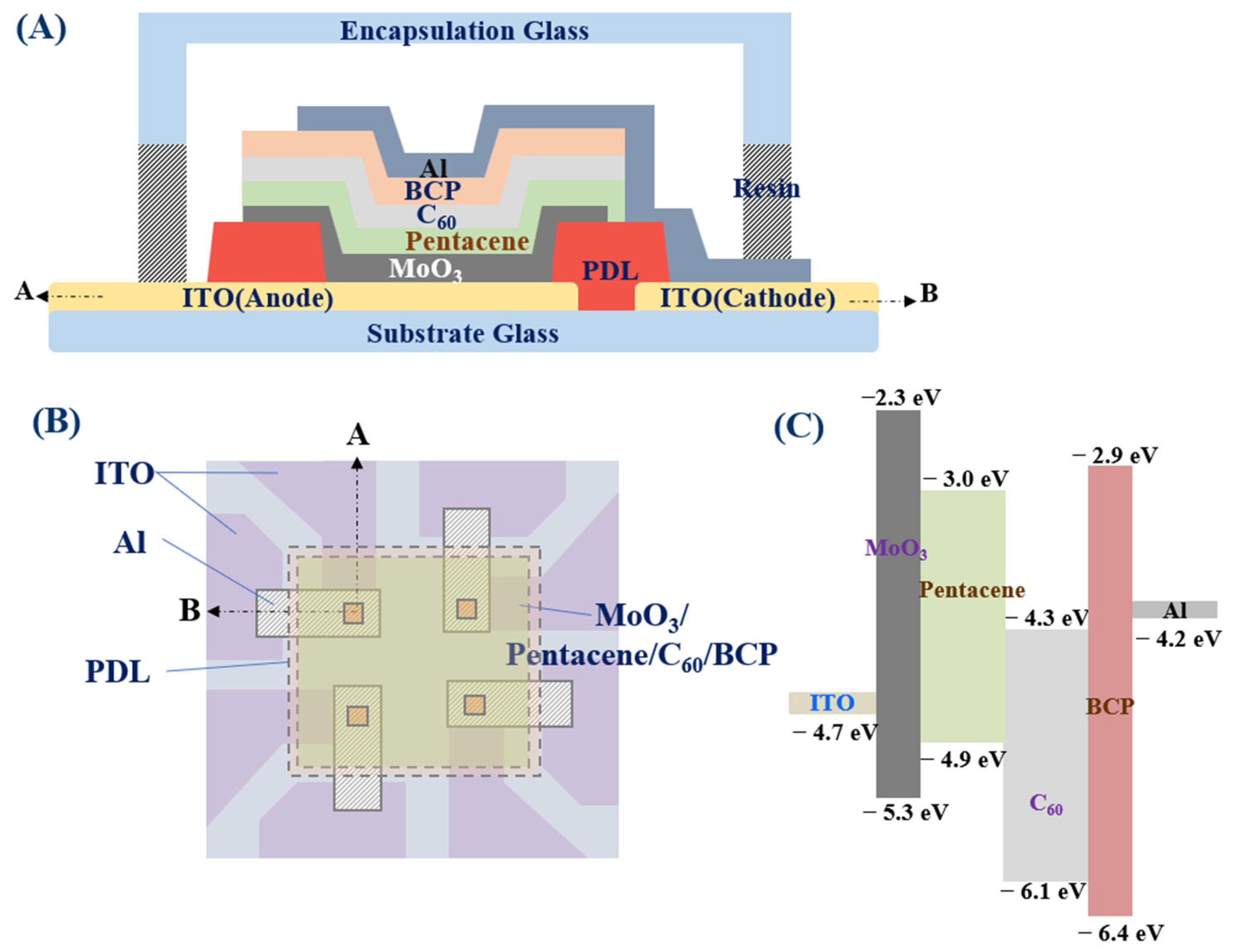
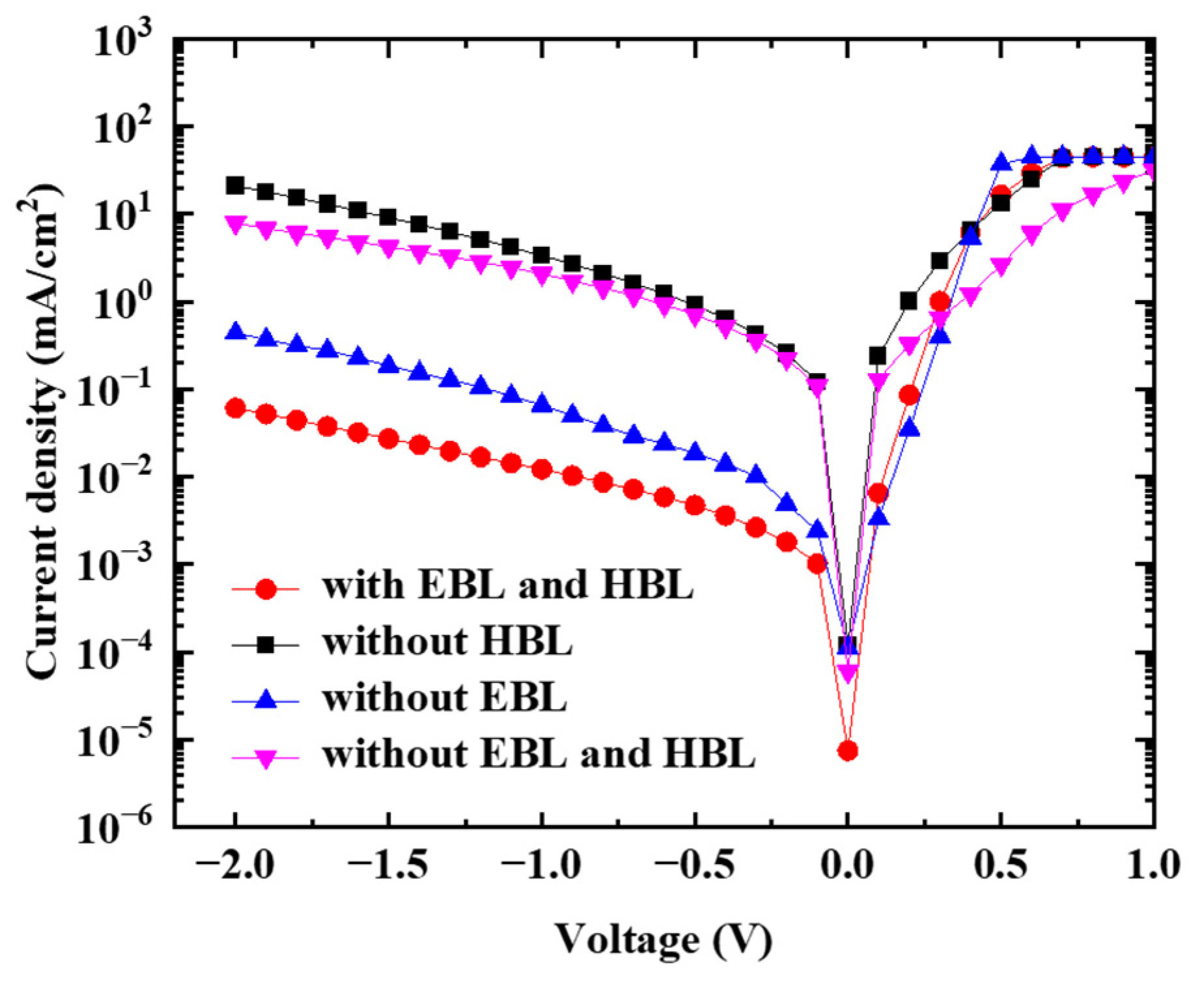
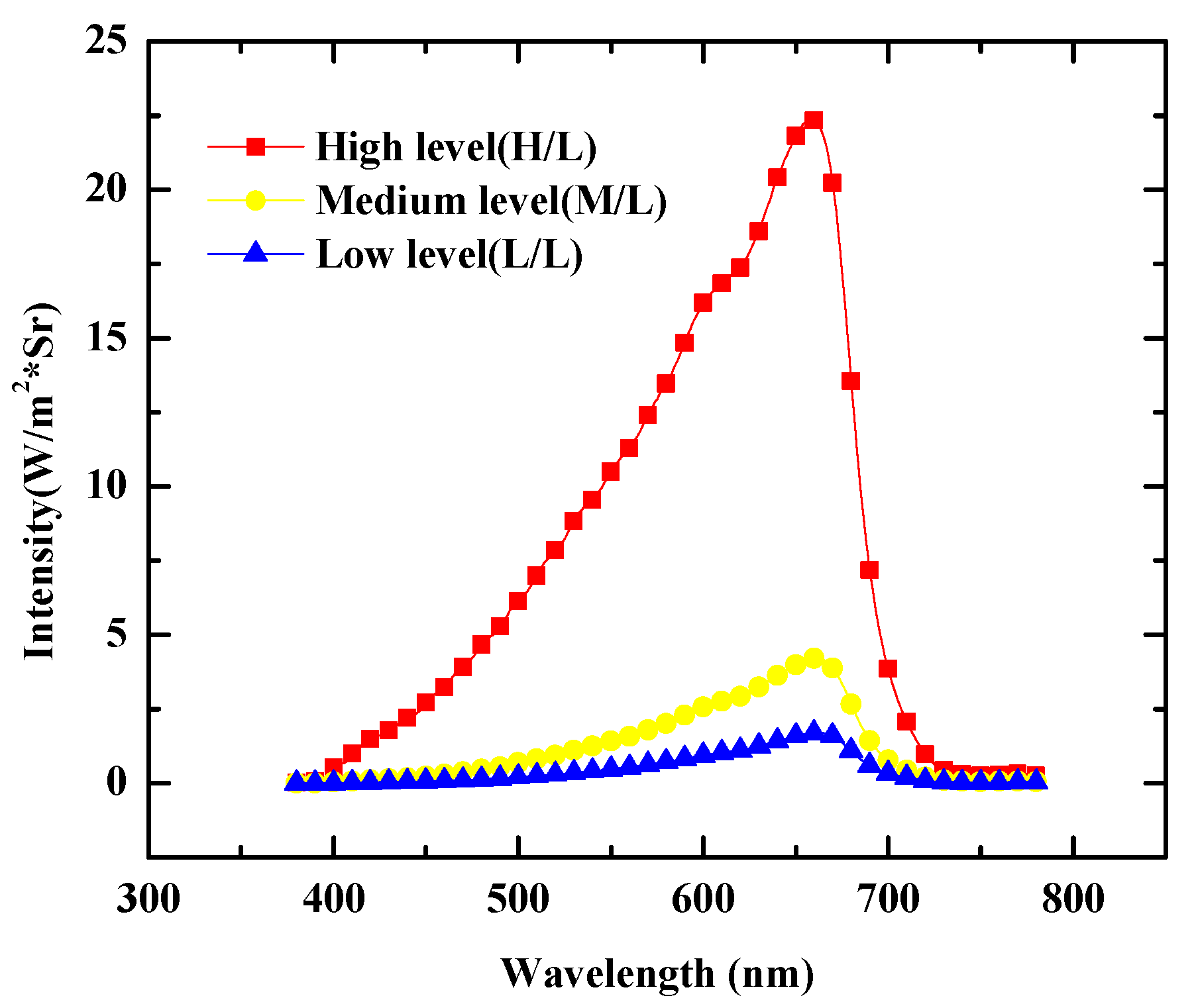
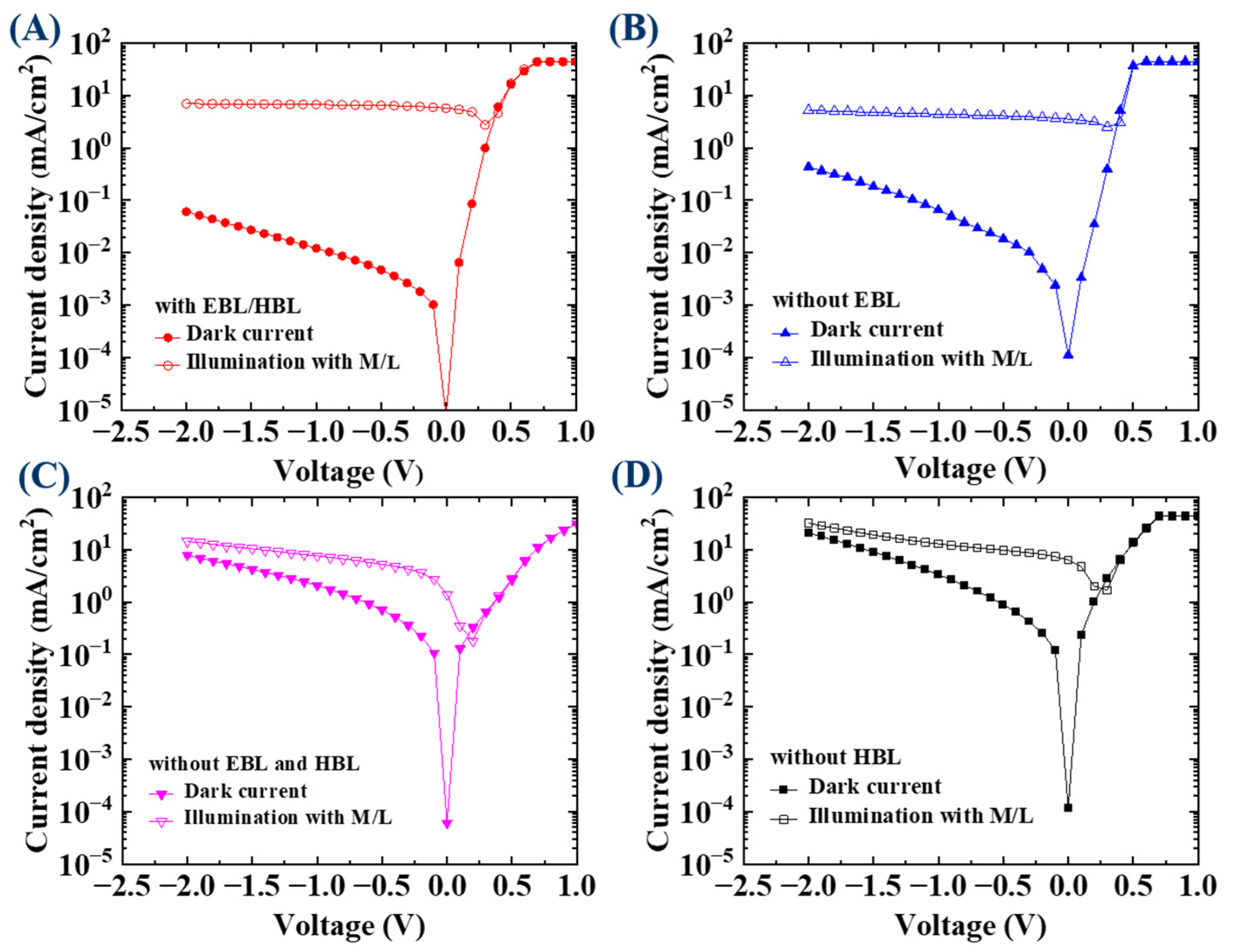
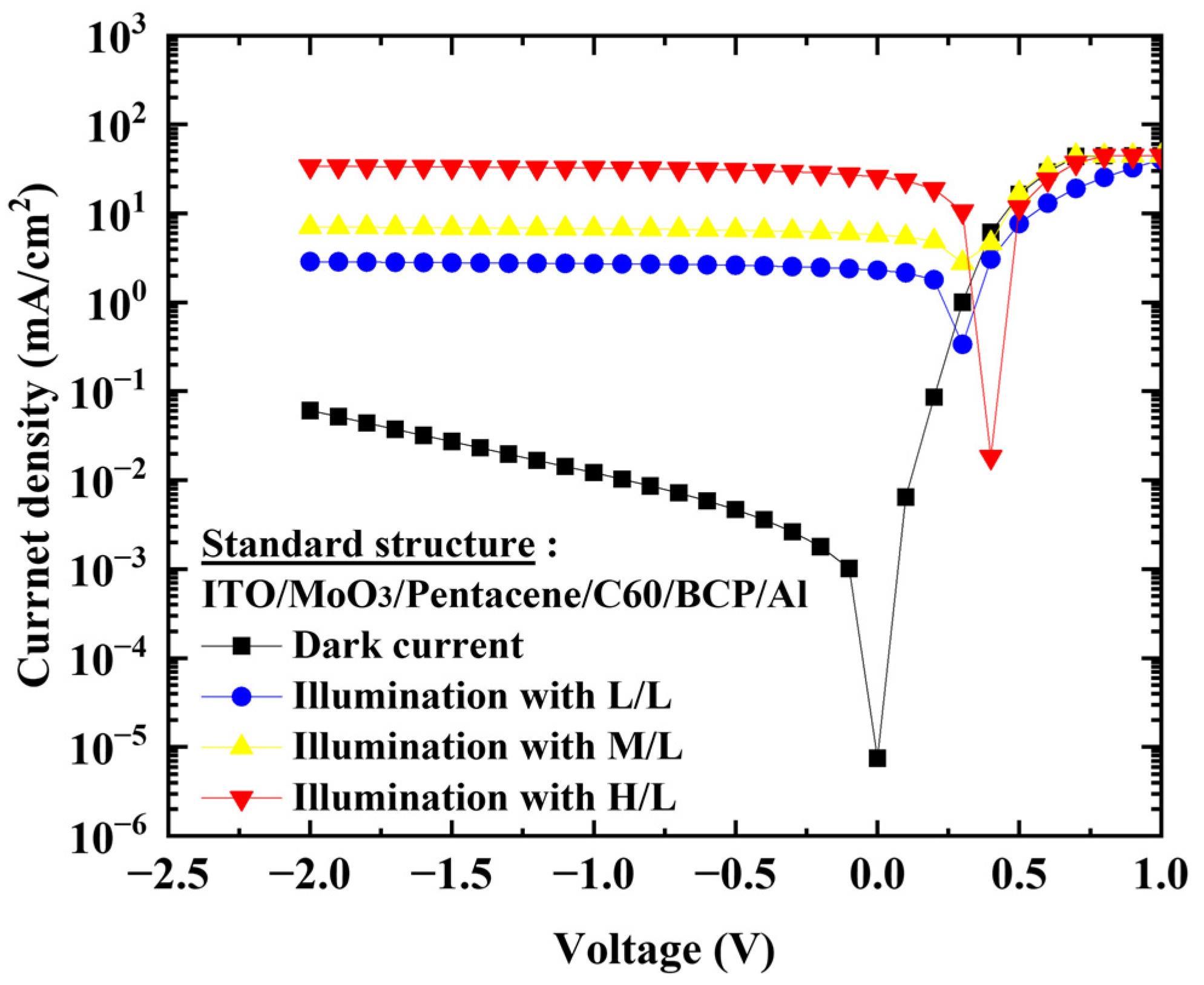

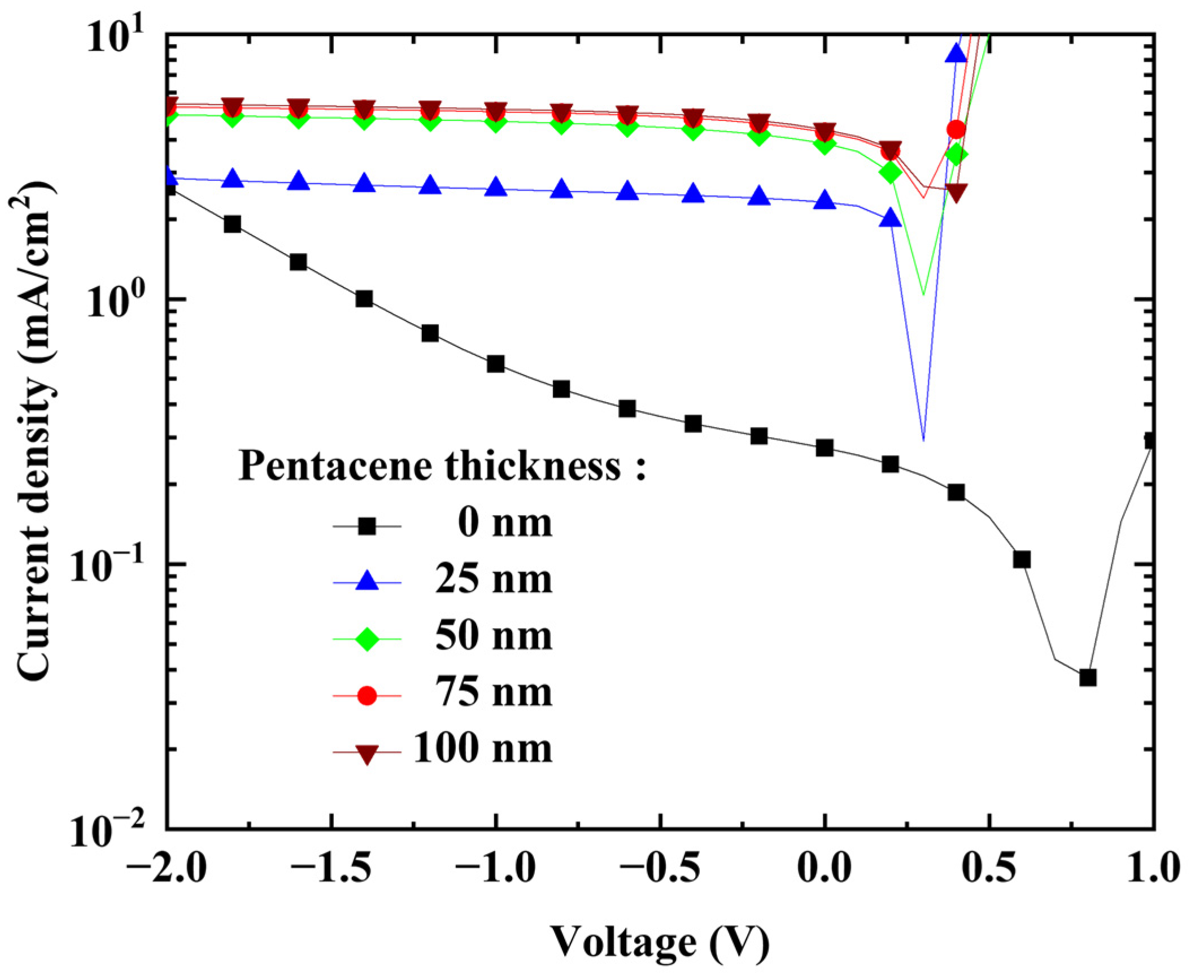

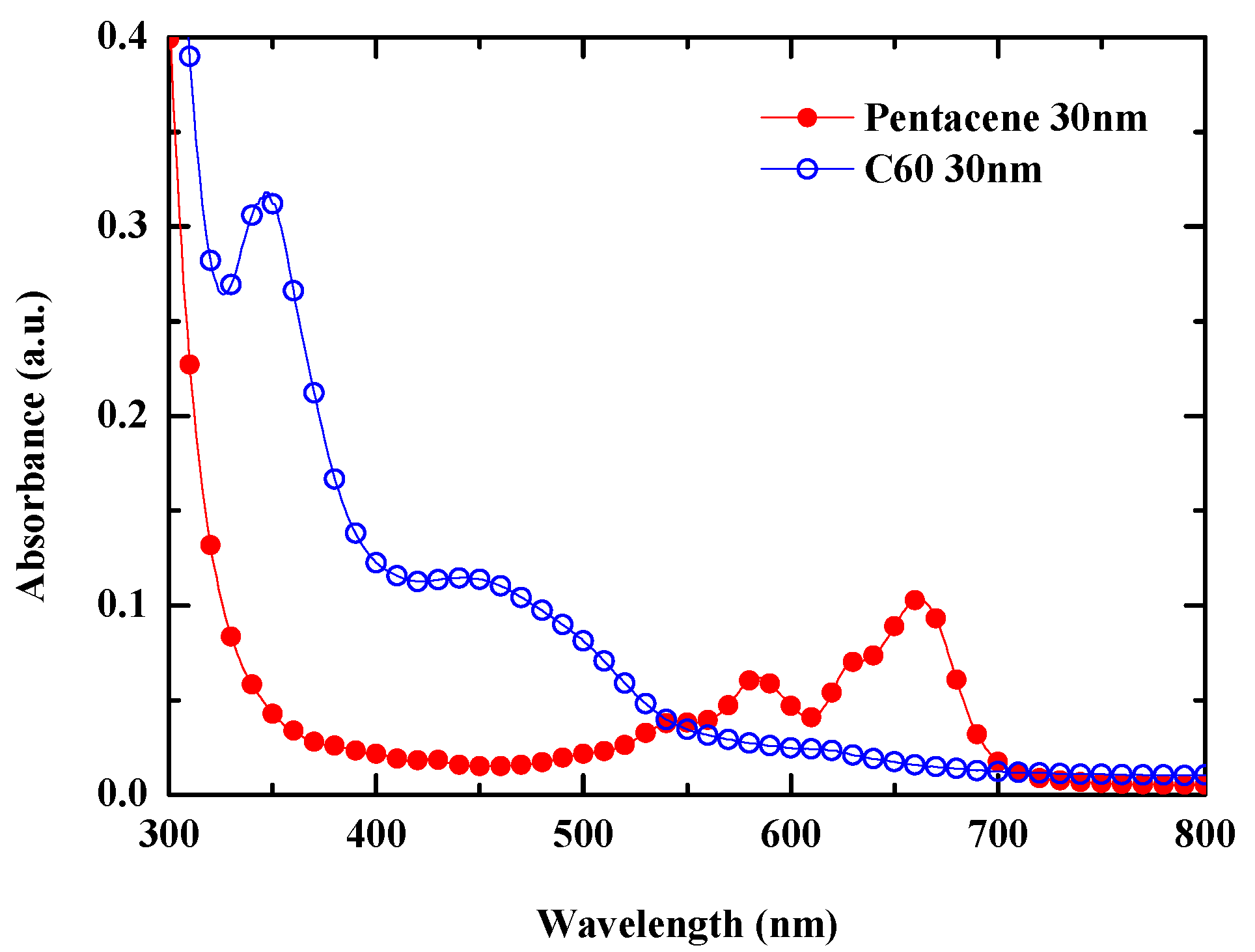

| Device Type | With Block Layers | w/o HBL | w/o EBL | w/o HBL and EBL | |
|---|---|---|---|---|---|
| Current | |||||
| Dark current (−1 V reversed) | −0.01217 mA/cm2 | −3.34673 mA/cm2 | −0.06581 mA/cm2 | −2.0675 mA/cm2 | |
| Medium illumination (−1 V reversed) | −6.73462 mA/cm2 | −12.9272 mA/cm2 | −4.42037 mA/cm2 | −7.64342 mA/cm2 | |
| On/Off Ratio | ×553.38 | ×3.86 | ×67.17 | ×3.70 | |
Disclaimer/Publisher’s Note: The statements, opinions and data contained in all publications are solely those of the individual author(s) and contributor(s) and not of MDPI and/or the editor(s). MDPI and/or the editor(s) disclaim responsibility for any injury to people or property resulting from any ideas, methods, instructions or products referred to in the content. |
© 2023 by the authors. Licensee MDPI, Basel, Switzerland. This article is an open access article distributed under the terms and conditions of the Creative Commons Attribution (CC BY) license (https://creativecommons.org/licenses/by/4.0/).
Share and Cite
Kim, Y.W.; Lee, D.; Jeon, Y.; Yoo, H.; Cho, E.-S.; Darici, E.; Park, Y.-J.; Seo, K.-I.; Kwon, S.-J. Analyses of All Small Molecule-Based Pentacene/C60 Organic Photodiodes Using Vacuum Evaporation Method. Nanomaterials 2023, 13, 2820. https://doi.org/10.3390/nano13212820
Kim YW, Lee D, Jeon Y, Yoo H, Cho E-S, Darici E, Park Y-J, Seo K-I, Kwon S-J. Analyses of All Small Molecule-Based Pentacene/C60 Organic Photodiodes Using Vacuum Evaporation Method. Nanomaterials. 2023; 13(21):2820. https://doi.org/10.3390/nano13212820
Chicago/Turabian StyleKim, Young Woo, Dongwoon Lee, Yongmin Jeon, Hocheon Yoo, Eou-Sik Cho, Ezgi Darici, Young-Jun Park, Kang-Il Seo, and Sang-Jik Kwon. 2023. "Analyses of All Small Molecule-Based Pentacene/C60 Organic Photodiodes Using Vacuum Evaporation Method" Nanomaterials 13, no. 21: 2820. https://doi.org/10.3390/nano13212820
APA StyleKim, Y. W., Lee, D., Jeon, Y., Yoo, H., Cho, E.-S., Darici, E., Park, Y.-J., Seo, K.-I., & Kwon, S.-J. (2023). Analyses of All Small Molecule-Based Pentacene/C60 Organic Photodiodes Using Vacuum Evaporation Method. Nanomaterials, 13(21), 2820. https://doi.org/10.3390/nano13212820








